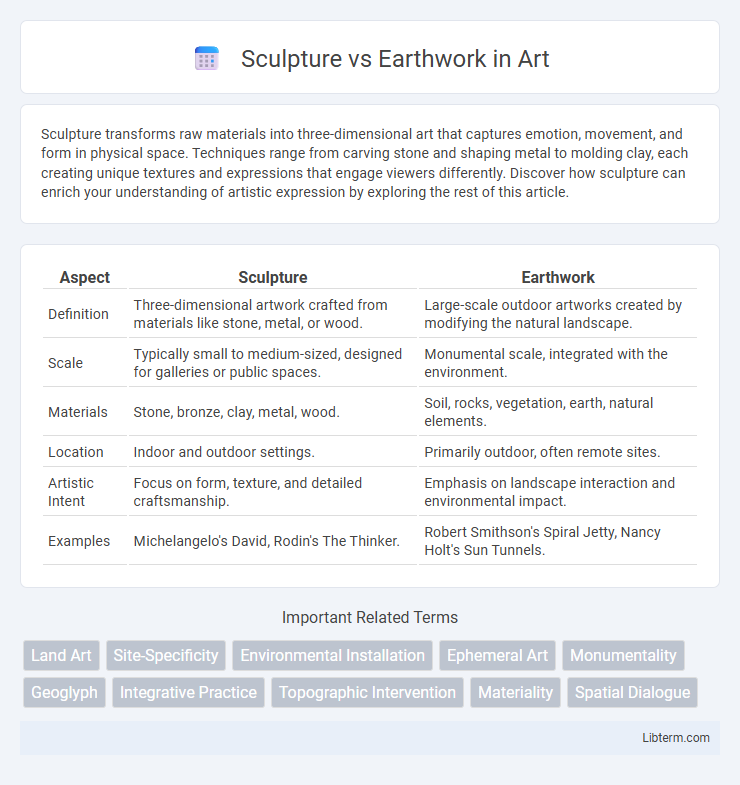Sculpture transforms raw materials into three-dimensional art that captures emotion, movement, and form in physical space. Techniques range from carving stone and shaping metal to molding clay, each creating unique textures and expressions that engage viewers differently. Discover how sculpture can enrich your understanding of artistic expression by exploring the rest of this article.
Table of Comparison
| Aspect | Sculpture | Earthwork |
|---|---|---|
| Definition | Three-dimensional artwork crafted from materials like stone, metal, or wood. | Large-scale outdoor artworks created by modifying the natural landscape. |
| Scale | Typically small to medium-sized, designed for galleries or public spaces. | Monumental scale, integrated with the environment. |
| Materials | Stone, bronze, clay, metal, wood. | Soil, rocks, vegetation, earth, natural elements. |
| Location | Indoor and outdoor settings. | Primarily outdoor, often remote sites. |
| Artistic Intent | Focus on form, texture, and detailed craftsmanship. | Emphasis on landscape interaction and environmental impact. |
| Examples | Michelangelo's David, Rodin's The Thinker. | Robert Smithson's Spiral Jetty, Nancy Holt's Sun Tunnels. |
Introduction to Sculpture and Earthwork
Sculpture is a three-dimensional art form created by shaping materials such as stone, metal, or wood to express artistic concepts or represent figures. Earthwork involves large-scale outdoor artworks integrated into the natural landscape, using soil, rocks, and vegetation to alter the environment. Both forms emphasize spatial presence, but earthwork uniquely engages with ecological and site-specific elements, contrasting the often portable or gallery-displayed nature of sculptures.
Historical Origins and Evolution
Sculpture originated in ancient civilizations such as Mesopotamia and Egypt, where artists shaped stone, metal, and clay to create religious and commemorative figures. Earthwork developed in the 1960s as a form of land art, with artists like Robert Smithson and Michael Heizer manipulating natural landscapes to create large-scale environmental installations. The evolution from traditional sculpture to earthwork reflects a shift in artistic focus from object-making to engaging with nature and spatial context on a monumental scale.
Key Materials and Techniques
Sculpture primarily utilizes materials such as marble, bronze, wood, and clay, employing techniques like carving, casting, and modeling to create three-dimensional art objects. Earthwork, also known as land art, involves natural elements like soil, rocks, plants, and water, crafted through processes including excavation, shaping, and land manipulation to integrate artworks into the environment. Both art forms emphasize materiality but differ in scale and interaction, with earthworks often designed for outdoor settings and larger spatial engagement.
Scale and Site Considerations
Sculpture typically emphasizes form and detail on a scale that allows close human interaction, often situated in galleries or urban spaces where the surrounding environment plays a supportive role. Earthworks are monumental in scale, integrating directly with the natural landscape to transform entire ecosystems or vistas, demanding extensive site-specific planning and environmental analysis. The scale and site considerations for earthworks prioritize harmony with topography and long-term ecological impact, contrasting with sculptures, which prioritize visual and tactile engagement within controlled settings.
Artistic Intent and Conceptual Approaches
Sculpture emphasizes form, materiality, and three-dimensional aesthetics, often aiming to evoke emotional or symbolic responses through crafted shapes and textures. Earthwork prioritizes environmental integration and site-specificity, using natural landscapes as both medium and message to challenge traditional art boundaries. Artistic intent in sculpture centers on object creation, while earthwork embraces ecological narratives and spatial interventions to engage viewers with place and time.
Relationship with Nature and Environment
Sculpture often emphasizes form and materiality, creating defined objects that interact visually with their surroundings but remain distinct from natural elements. Earthworks integrate directly into the landscape, using natural materials like soil, rocks, and vegetation to transform the environment and highlight ecological processes. This symbiotic relationship in earthworks fosters a dynamic dialogue with nature, emphasizing harmony and environmental context over isolated artistic expression.
Notable Artists and Landmark Works
Sculpture features artists like Auguste Rodin, known for "The Thinker," and Henry Moore, famed for organic abstract forms, emphasizing material manipulation. Earthwork highlights Robert Smithson, creator of the "Spiral Jetty," and Michael Heizer, known for monumental land modifications such as "Double Negative," focusing on environmental integration. Both mediums challenge traditional art boundaries but differ in scale, materials, and interaction with nature.
Preservation and Longevity Challenges
Sculpture preservation demands careful protection from environmental factors such as moisture, temperature fluctuations, and pollutants, often requiring controlled indoor conditions or specialized coatings to prevent material degradation. Earthwork, exposed directly to natural elements like rain, wind, and vegetation growth, faces accelerated erosion and shifting landscapes, posing challenges for maintaining its original form and meaning over time. Preservation of earthworks frequently involves ongoing landscape management and community engagement to balance ecological processes with the artwork's longevity.
Public Engagement and Cultural Impact
Sculpture often serves as a tangible focal point in public spaces, inviting direct interaction and fostering community identity through accessible forms and recognizable materials. Earthwork integrates the natural environment into its design, encouraging immersive experiences that connect audiences with ecological and cultural narratives on a broader scale. Both art forms significantly influence public engagement by shaping cultural perceptions, promoting environmental awareness, and enhancing collective memory within diverse communities.
Future Trends in Sculpture and Earthwork
Future trends in sculpture and earthwork emphasize sustainability and interactive experiences, integrating eco-friendly materials and renewable resources to minimize environmental impact. Advancements in technology such as augmented reality (AR) and 3D printing are reshaping sculptural forms, allowing for dynamic, site-specific installations that engage audiences on multiple sensory levels. Collaborative projects between artists, environmental scientists, and local communities drive innovative earthworks that respond to climate change and cultural narratives, expanding the scope of public art.
Sculpture Infographic

 libterm.com
libterm.com